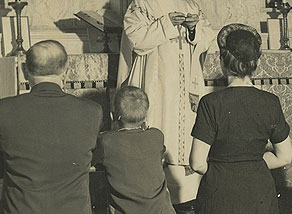November 12, 2013
That Old Time Religion: Looking Beyond Heyday History, Part 1
 I’d be the first to admit that I have a chip on my shoulder when it comes to nostalgia. It’s a generational thing. Born in 1971, I grew up hearing that the sixties were AWESOME (or maybe it was GROOVY??). Ordained in 2000, I have heard throughout my ministry that those dusty balconies and rented-out Sunday school wings used to JAMMED with people. As a woman priest, I regularly hear how the whole church thing pretty much started coming unglued...oh, somewhere in the 1970s. So you’ll indulge me if I get a little tired of hearing how much better everything was just before my generation arrived on the scene.
I’d be the first to admit that I have a chip on my shoulder when it comes to nostalgia. It’s a generational thing. Born in 1971, I grew up hearing that the sixties were AWESOME (or maybe it was GROOVY??). Ordained in 2000, I have heard throughout my ministry that those dusty balconies and rented-out Sunday school wings used to JAMMED with people. As a woman priest, I regularly hear how the whole church thing pretty much started coming unglued...oh, somewhere in the 1970s. So you’ll indulge me if I get a little tired of hearing how much better everything was just before my generation arrived on the scene.
I’m down on nostalgia, but I’m a firm believer in history. It’s important to know the difference. Too often when we look to the past, we engage in what I like to call “Heyday History.” We remember the peak of our success (as defined by the standard “butts & bucks” formula: butts in the pews + bucks in the plate = church), and lament our current decline.
There are at least a couple of problems with Heyday History. One, while every parish has its own version of the Heyday, a remarkable number of those occurred in the space the same few mid-twentieth century decades. We’ll call that the Big Heyday. The Big Heyday was a cultural anomaly. Many of the reasons for the Heyday in church life had to do with a convergence of socioeconomic conditions that had very little to do with Jesus or even the quality of ministry.
Even when it comes to local Heydays that may or may not have been tied to the national cultural moment, Heydays by definition contain the seeds of their own downfall. When did church participation start to decline? Well...that would be right after the Heyday. All those kids in the Sunday School wing wandered off. All those people who seemed so inspired by our worship started playing soccer on Sunday mornings instead. That ministry that had everyone all excited about the future turned out not to have been sustainable. And so on.
Most Heyday History is nostalgia, just posing as helpful history. When studied (or worshipped) uncritically, it teaches us everything backward, and devalues both the hard work that led to building up Heyday churches, and every faithful thing that has happened since.
When did your church have its heyday? To what degree was that heyday impacted by the national cultural moment of that time?
For my money, it’s much more useful to go back...way back. In Part 2, I’ll take you back 100 years to the founding of my parish in Los Angeles.
Read Part 2 here.





